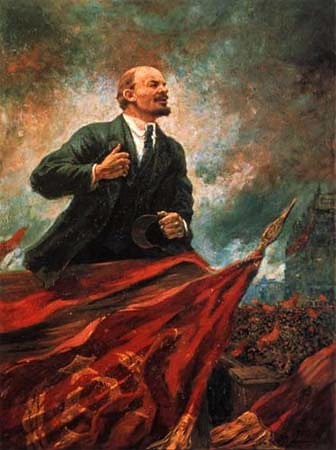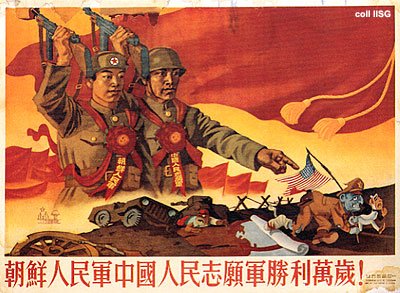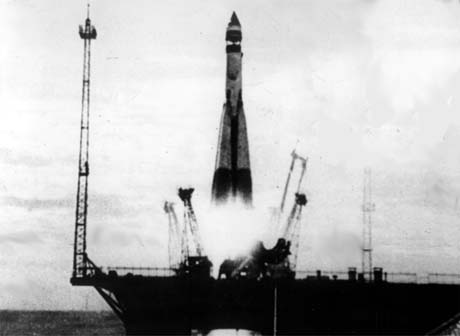1917 - Communist Revolution in Russia  The Russian Revolution is the collective term for the series of revolutions in Russia in 1917, which destroyed the Tsarist autocracy and led to the creation of the Soviet Union. In the first revolution of February 1917 (March in the Gregorian calendar), the Tsar was deposed and replaced by a Provisional government. In the second revolution, during October, the Provisional Government was removed and replaced with a Bolshevik (Communist) government. The Russian Revolution is the collective term for the series of revolutions in Russia in 1917, which destroyed the Tsarist autocracy and led to the creation of the Soviet Union. In the first revolution of February 1917 (March in the Gregorian calendar), the Tsar was deposed and replaced by a Provisional government. In the second revolution, during October, the Provisional Government was removed and replaced with a Bolshevik (Communist) government. |
1945 - End of World War II The final battles of the European Theatre of World War II as well as the German surrender took place in late April and early May 1945. |
1945 - Germany Splits As a consequence of Germany's defeat in World War II and the onset of the Cold War, the country was split between the two global blocs in the East and West, a period known as the division of Germany. Two states emerged; West Germany was a parliamentary democracy, a NATO member, a founding member of what since became the European Union and one of the world's largest economies, while East Germany was a totalitarian Stalinist dictatorship allied with the Soviet Union, widely considered to be a Soviet satellite state. Germany would not be reunited until 1990, following the collapse of the East German communist regime. |
1949 - Communists Control China  The Chinese Civil War was a civil war fought between the Kuomintang (KMT or Chinese Nationalist Party), the governing party of the Republic of China and the Communist Party of China (CPC).The war began in April 1927, amidst the Northern Expedition. The war represented an ideological split between the Western-supported Nationalist KMT, and the Soviet-supported Communist CPC. In the People's Republic of China, the war is more commonly known as the "War of Liberation". The Chinese Civil War was a civil war fought between the Kuomintang (KMT or Chinese Nationalist Party), the governing party of the Republic of China and the Communist Party of China (CPC).The war began in April 1927, amidst the Northern Expedition. The war represented an ideological split between the Western-supported Nationalist KMT, and the Soviet-supported Communist CPC. In the People's Republic of China, the war is more commonly known as the "War of Liberation".
The civil war carried on intermittently until the Second Sino-Japanese War interrupted it, resulting in the two parties forming a Second United Front. Japan's campaign was defeated in 1945, marking the end of World War II, and China's full-scale civil war resumed in 1946. After a further four years, 1950 saw a cessation of major military hostilities—with the newly founded People's Republic of China controlling mainland China (including Hainan Island), and the Republic of China's jurisdiction being restricted to Taiwan, Penghu, Kinmen, Matsu and several outlying Fujianese islands. To this day, since no armistice or peace treaty has ever been signed, there is controversy as to whether the Civil War has legally ended.Today, the two sides of the Taiwan strait have close economic ties
|
1949 - Soviets Test Nuclear Technology The Soviet project to develop an atomic bomb began during World War II in the Soviet Union. The program was started after Stalin learned of the American efforts to develop an Atomic bomb. The scientific research was directed by noted Soviet nuclear physicist Igor Kurchatov. The USSR tested its first nuclear weapon in Aug. 1949 |
1954 - Communists Invade Vietnam
 The Vietnam War was a Cold War military conflict that occurred in Vietnam, Laos, and Cambodia from November 1, 1955, to April 30, 1975 when Saigon fell. This war followed the First Indochina War and was fought between the communist North Vietnam, supported by its communist allies, and the government of South Vietnam, supported by the United States and other anti-communist nations. The Vietnam War was a Cold War military conflict that occurred in Vietnam, Laos, and Cambodia from November 1, 1955, to April 30, 1975 when Saigon fell. This war followed the First Indochina War and was fought between the communist North Vietnam, supported by its communist allies, and the government of South Vietnam, supported by the United States and other anti-communist nations. |
1955 - Austrian State Treaty  The Austrian State Treaty or Austrian Independence Treaty re-established Austria as a sovereign state. It was signed on May 15, 1955, in Vienna at the Schloss Belvedere among the Allied occupying powers (France, the United Kingdom, the United States, and the Soviet Union) and the Austrian government. It officially came into force on July 27, 1955. The Austrian State Treaty or Austrian Independence Treaty re-established Austria as a sovereign state. It was signed on May 15, 1955, in Vienna at the Schloss Belvedere among the Allied occupying powers (France, the United Kingdom, the United States, and the Soviet Union) and the Austrian government. It officially came into force on July 27, 1955. |
1957 - Sputnik Satellite Launched  The Sputnik program, which is translated as 'companion') was a series of robotic spacecraft missions launched by the Soviet Union. The first of these, Sputnik 1, launched the first human-made object to orbit the Earth. That launch took place on October 4, 1957 as part of the International Geophysical Year and demonstrated the viability of using artificial satellites to explore the upper atmosphere. The Sputnik program, which is translated as 'companion') was a series of robotic spacecraft missions launched by the Soviet Union. The first of these, Sputnik 1, launched the first human-made object to orbit the Earth. That launch took place on October 4, 1957 as part of the International Geophysical Year and demonstrated the viability of using artificial satellites to explore the upper atmosphere.
The Russian word sputnik literally means "co-traveler", "traveling companion" or "satellite",[note 1] and its R-7 launch vehicle was designed initially to carry nuclear warheads.
|